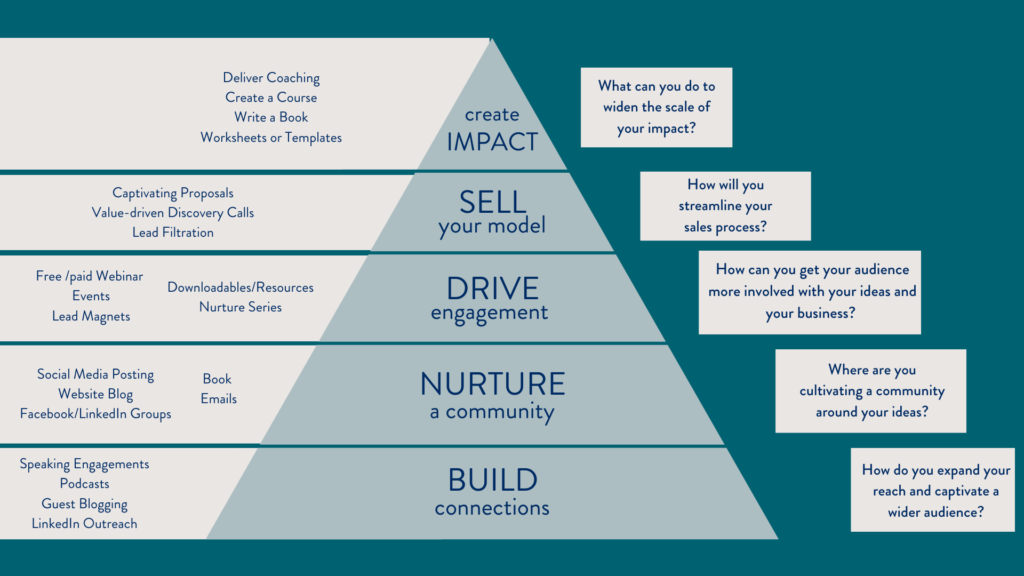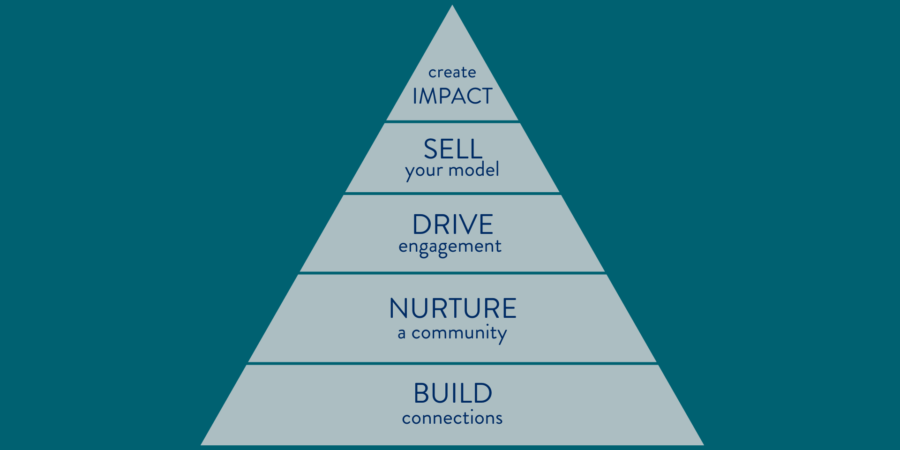The Impact Pyramid™: How to focus your thought leadership efforts for maximum impact
When you want to maximise your impact as a thought leader, it can feel like you need to try and do everything. To be on every social media platform, to be out speaking, to be sending constant emails, to be blogging, to be networking, to be doing weekly webinars, to be pitching yourself to media… whew!
But here’s the good news – you don’t have to be everywhere in order to build thought leadership. In fact, you’ll have far more impact if you focus your efforts in a few key areas and do those really well.
So how do you decide where to focus your efforts? It all starts with The Impact Pyramid™ (and don’t worry – once I explain the model, I’ll share how you can use it to figure out where your priorities are!):

This model shows us where each element of a thought leadership journey sits in relation to one another. Your audience might find you at any level of this pyramid, but once they are exposed to your ideas, they will be able to see and explore your entire structure.
The goal should be to have a balanced pyramid, with a few different focus areas for each layer. Deciding which elements to hone in on will help you define your strategy and cut out the overwhelm that often happens when we try to prioritise the next move!
BUILD: Finding your people
At the Build stage, it’s all about finding and building your community. That could mean networking and connecting with those who will challenge you, rave about you, or connect you with others.
It could include:
- Speaking
- Going on podcasts
- Connecting with people in your target audience on LinkedIn
- Even paid ads (although I would save those until you’re further down your journey and have the rest of the pyramid working really well).
The Build stage is all about finding and connecting with your people — those who will gain value from your ideas, challenge them, or share them with their networks. That community may become part of your peer network, your industry partners, or they might be potential clients.
NURTURE: Turning connections into community
Once you’ve built that community, it’s time to Nurture them. How are you developing your relationships? How are you providing them with consistent value? How are you sharing your ideas so that they can learn from them and use them in their own lives and businesses?
The Nurture stage could include sending emails (either as a newsletter or as a nurture series), LinkedIn posts (and don’t forget commenting on other people’s content!), your book, blogs, events, a Facebook group, or any number of other activities.
The Nurture stage is designed to do three things:
- Strengthen your relationships with your community
- Spread your ideas so people can engage with them
- Filter out the people who aren’t the right fit for you and your business
DRIVE: Giving people an opportunity to engage
While we believe thought leaders should share their ideas generously, we do all have businesses to grow. So how do you take someone from the Nurture stage into becoming a prospective client? You Drive them to take action.
This could look like a number of things:
- A free (or paid) webinar or event
- A lead magnet that is followed up by a nurture series
- Outreach to target clients to set up a conversation, or
- <add extra ideas following TSTL brainstorm>.
Now, not everyone in your community will want to become a client – and that’s totally okay! The key here is to give those who do want to work with you further a chance to ‘test you out’ a little – to experience your ideas in a different way that will give them a taste of what it would be like to work with you. And of course, give them a way to then engage with you and go into…
SELL: Taking your relationships to the next level
Your sales process. Much as it’s nice to think that people will just magically choose to work with us and hand over money at the first request, that’s pretty unlikely. Whether you’re selling an online product with no person-to-person contact or having 2-3 calls with any prospective client, this is still an opportunity to build thought leadership and maximise your impact.
So how can you weave your thought leadership through your sales process to ensure that it’s valuable for every person who comes through it?
Consider the questions you ask:
- Do they demonstrate a deep understanding of your area of expertise?
- Will the person you’re talking to understand something about themselves that they didn’t before?
- Are you successfully filtering out those who won’t get value from your ideas?
Once you’ve sold (to the right people), then it’s time to have an…
IMPACT: Helping the people you were born to serve
This is the part we all love. It’s why you went into business, right? It’s working with clients, teaching them your expertise, or guiding them towards their vision for the future. It’s helping them apply your ideas, frameworks, and models to their own lives or businesses. It’s working towards your purpose, and your vision for the future.
This is the heart of your thought leadership – it’s where all your ideas come from. At this stage, you want to be looking at how to capture what you do with clients in a way that can be expanded and shared with a wider audience:
- Can you create templates for what you do so that you consistently get to the same result?
- Are there worksheets or workbooks that would enable your clients to get to the right place?
- Could you create an online course, or a mastermind where you can guide clients through your expertise?
At Impact, it’s all about asking yourself – how can I have the biggest impact with the least effort? Because once you nail that, you’ll really have maximised your impact as a thought leader.
Bringing a thought leadership lens to every stage
Next I’ll look at how you can use The Impact Pyramid™ to decide what to focus on but first a quick disclaimer.
Keep in mind that although many of these stages match a marketing funnel, there is a key difference – with this approach, your thought leadership should be carried through every stage. Meaning? You could have one idea (for example, a framework or model) that carries through every stage.
At the Nurture stage, you could be using that framework as the basis for your keynote speech. For example, our client Suzi McAlpine now speaks often about burnout, based on the framework she developed in her book Beyond Burnout.
At Build, you could base a huge number of blogs, emails, and social posts around one framework alone. Suzi weaves that burnout framework through her book, some of the articles on her blog The Leader’s Digest, her emails, and her social media.
At Drive, you could turn that framework into a downloadable workbook, or run it as a webinar. Suzi has a downloadable worksheet that guides people through her framework and leads into a nurture series.
At Sell, you could guide people through questions that highlight why they need the framework, or look at how you use the framework in your offerings. (I’m just assuming Suzi does this as I’ve never been through her process myself – but knowing how amazing she is, I suspect she does!).
And at Impact, you’re applying that framework to your clients through your offerings, whether that’s you implementing it for them, one-on-one coaching/advising, or through a group programme or online course. Suzi has a mix of paid speaking, workshops, and a coming-soon online course which all use the same framework.
With thought leadership, you’re not leading with the product or service – lead with the idea, and make sure that all your activities eventually guide them towards your product or service instead.
Deciding where to start
Alright, now we’re getting to the action part. You know you need all of those stages, but how do you know where (and when) to focus your efforts?
Here’s the thing – above are many of the things you COULD be doing. But you don’t need to (and I’d argue, shouldn’t) do them all.
So as you decide where to focus your efforts, here’s what I’d recommend:
- For each stage of The Impact Builder™, list all the things you think would be relevant for you and your target audience.
- For the Build and Nurture stages, pick one ‘consistent’ activity (i.e. LinkedIn) and one ‘project’ (i.e. setting up an email nurture series).
- For the other stages, pick one project to work on.
- Prioritise the projects into the order you think will have the biggest impact on your business – just choose ONE at a time.
- Split your thought leadership time between working on your consistent activities and working on the one project you’ve chosen.
- Once you’ve finished those projects, repeat steps 2-5 until you’re consistently having the impact you want both on the people you’re here to serve and on your business.
Keep in mind that you want to ensure your pyramid is balanced – so as you grow or shrink a layer, make sure it’s sitting on a solid base below it.
Need more help deciding where to focus your efforts for thought leadership? We work on this as part of our programme The Strategic Thought Leader. Book a call with Verity to find out if you could be the right fit for our next cohort.


